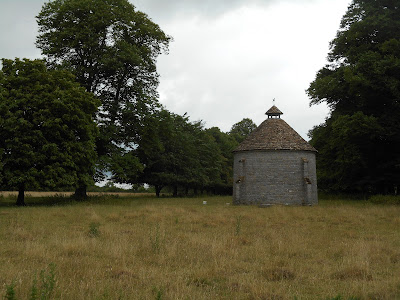Most surviving dovecotes in the UK date from the 14th-18th centuries. They were built of stone, brick or timber and were either free-standing or built into the end of a house or barn. The inside of the dovecote was lined with nesting places for the pigeons - nest-holes if they were built into the solid walls or nest-boxes if they were constructed separately. Until the 18th century the doorways were small, so that the pigeon keeper could block it with his body as he entered. In Scotland dovecotes are called doocots.
Many dovecotes were in use until the French Revolutionary Wars began in 1793. This had the effect of increasing the price of grain, which made it more profitable to sell it than to feed it to the pigeons. By the mid-19th century they had nearly all ceased to be used as dovecotes. Many of the buildings were adapted for other uses.
Historic dovecotes are not particularly common in Somerset. These are the ones I have come across so far:
Bruton Dovecote
 |
| Bruton Dovecote |
Dunster
Dunster Dovecote was originally built in the 13th century as part of Dunster Priory. After the dissolution of the monastery in 1539 the land was purchased by the Luttrell family. The current building dates from the late 16th century. It has a revolving ladder inside, which was the means by which the squabs were removed from their nests.
Inside Duster Dovecote
Dunster
Stogursey
Shapwick

Stogursey
This dovecote was once part of the Benedictine Priory at Stogursey, which was founded c1100 and dissolved c1442. The priory church also survives as the current parish church. The dovecote was originally medieval but was rebuilt in 1925 apart from the steps.
Shapwick
This
dovecote is located in the grounds of Shapwick Manor, which is on the
west side of Station Road in Shapwick. It was originally built in the
medieval period but was rebuilt in the 18th or 19th centuries and was
re-roofed in the 20th century.

Norton-sub-Hamdon
The dovecote is located in the churchyard.
Stoke-sub-Hamdon Priory
This is as close to the roofless dovecote as you can get without trespassing
West Camel
West Camel's dovecote is located on private land and this was the best photo I could get of it from the road. It might be a bit more visible in the winter when the leaves are not on the trees.
Lytes Cary
This is not a dovecote but a water tower designed to look like a dovecote.
Replica dovecote at The Newt in Somerset near Castle Cary
This dovecote, which is built from Ham stone, probably dates from the 17th century, but may have originated in the 15th century.
In about 1600 the roof of the chancel of St Michael's Church in Compton Martin was raised to create a columbarium or dovecote. This was rare in a church. It would have housed about 140 pigeons for the Rector of the time to eat. The only record of its use was in 1605.
















Fascinating buildings. I’ve come across a few in the northwest and Scotland over the years, and just wish I could remember where. There’s really no reason why they couldn’t again be in use.
ReplyDelete